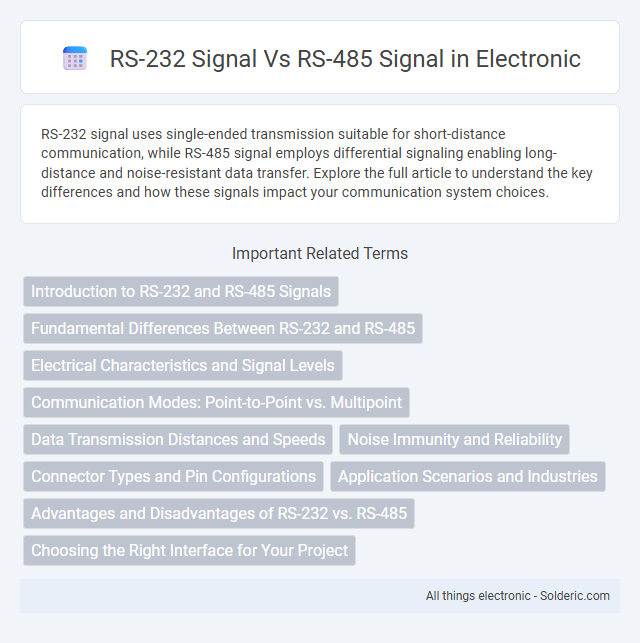RS-232 signal uses single-ended transmission suitable for short-distance communication, while RS-485 signal employs differential signaling enabling long-distance and noise-resistant data transfer. Explore the full article to understand the key differences and how these signals impact your communication system choices.
Comparison Table
| Feature | RS-232 Signal | RS-485 Signal |
|---|---|---|
| Signal Type | Single-ended | Differential |
| Max Cable Length | 15 meters (50 feet) | 1200 meters (4000 feet) |
| Number of Devices | 1 transmitter, 1 receiver | Up to 32 nodes on a bus |
| Voltage Levels | +-3V to +-15V | +-1.5V (differential) |
| Noise Immunity | Low | High (due to differential signaling) |
| Data Transmission | Full duplex | Half duplex (typically) |
| Common Use | Short distance, point-to-point | Long distance, multi-drop networks |
Introduction to RS-232 and RS-485 Signals
RS-232 signals utilize single-ended transmission with voltage levels ranging from -15V to +15V, making them suitable for short-distance, point-to-point serial communication. RS-485 signals employ differential signaling with balanced voltage lines, supporting longer distances up to 4,000 feet and multi-drop network configurations. The robust noise immunity and higher data rates of RS-485 make it ideal for industrial automation and complex communication environments compared to the simpler RS-232 standard.
Fundamental Differences Between RS-232 and RS-485
RS-232 utilizes single-ended signaling with voltage levels ranging from +3 to +15 V for logic 0 and -3 to -15 V for logic 1, primarily supporting point-to-point communication over short distances up to 15 meters. RS-485 employs differential signaling with balanced lines, enabling noise reduction and data transmission over longer distances up to 1.2 kilometers while supporting multi-point networks with up to 32 devices on the same bus. The differential nature of RS-485 enhances immunity to electromagnetic interference, making it ideal for industrial and robust communication environments compared to the simpler, less noise-resistant RS-232 interface.
Electrical Characteristics and Signal Levels
RS-232 signals operate with voltage levels ranging from -15V to +15V, where a voltage between +3V to +15V represents a logical '0' and -3V to -15V represents a logical '1', relying on single-ended communication over short distances. RS-485 signals use differential signaling with voltage swings around 1.5V to 5V between two lines (A and B), enabling robust noise immunity and communication over longer distances up to 1.2 km. Your choice between RS-232 and RS-485 depends on the required communication distance, noise environment, and whether point-to-point or multi-point topology is needed.
Communication Modes: Point-to-Point vs. Multipoint
RS-232 supports point-to-point communication, allowing direct data exchange between two devices, typically over short distances with single-ended signaling. RS-485 enables multipoint communication, supporting multiple devices on the same bus through differential signaling, which enhances noise immunity and extends transmission distance. This makes RS-485 ideal for industrial networks requiring multi-drop configurations, whereas RS-232 suits simpler, device-to-device links.
Data Transmission Distances and Speeds
RS-232 signals typically support data transmission distances up to 15 meters at speeds around 115 kbps, making it suitable for short-distance, point-to-point communication. In contrast, RS-485 signals can transmit data over much longer distances, reaching up to 1,200 meters while maintaining speeds up to 10 Mbps at shorter spans. The differential signaling of RS-485 enhances noise immunity and supports multi-drop configurations, significantly outperforming RS-232 in industrial and networked environments.
Noise Immunity and Reliability
RS-485 signals offer superior noise immunity compared to RS-232 due to differential signaling, which significantly reduces electromagnetic interference over long distances. This enhanced noise resistance improves reliability in industrial environments where electrical noise is prevalent. Your communication setup benefits from RS-485's robustness, ensuring more stable and consistent data transmission in challenging conditions.
Connector Types and Pin Configurations
RS-232 signals primarily use DB9 or DB25 connectors with single-ended pin configurations designed for unidirectional communication. RS-485 signals employ terminal block connectors or RJ45 connectors with differential signaling pin configurations that enable multi-point and bidirectional data transfer. The distinct pin layouts reflect RS-232's point-to-point topology versus RS-485's multipoint network capability.
Application Scenarios and Industries
RS-232 signals are commonly used in point-to-point communication setups such as serial ports on computers, industrial automation devices, and laboratory instruments for short-distance, low-speed data transfer. RS-485 signals excel in multi-drop network environments, supporting longer cable lengths and higher noise immunity, making them ideal for building automation, factory control systems, and transportation applications. Industries such as manufacturing, energy management, and security systems benefit from RS-485's robust communication capabilities in complex, electrically noisy settings.
Advantages and Disadvantages of RS-232 vs. RS-485
RS-232 signals support simple point-to-point communication with short distance and low speed limitations, making them ideal for connecting individual devices like computers to peripherals. RS-485 signals enable multi-point communication over longer distances and higher data rates while providing better noise immunity and differential signaling advantages. Your choice depends on whether you require straightforward, short-range connections (RS-232) or extended multi-device network capabilities with robust performance (RS-485).
Choosing the Right Interface for Your Project
RS-485 signals provide robust, long-distance communication and support multi-point networks, making them ideal for industrial automation and environments with electrical noise. RS-232 signals are best suited for short-distance, point-to-point connections with simpler wiring requirements, commonly used in legacy systems and direct device communication. When choosing the right interface for your project, consider the communication range, network complexity, and noise resistance to ensure reliable data transmission.
RS-232 signal vs RS-485 signal Infographic

 solderic.com
solderic.com